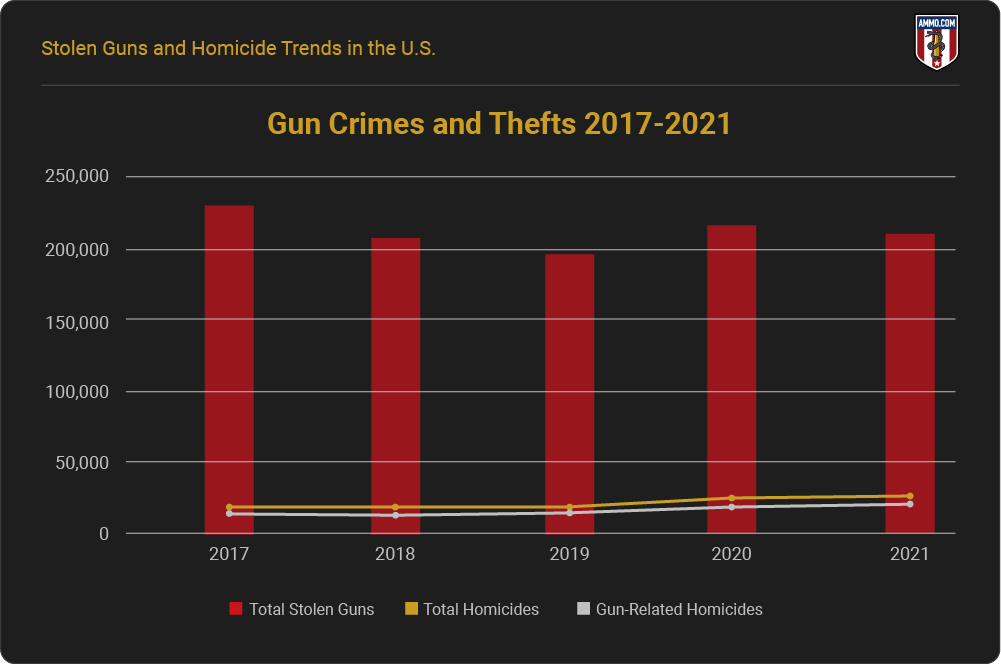A Silent Contributor to Gun Crimes in the U.S. (2024)
Report Highlights
- 1,074,022 firearms were reported stolen in the U.S. from 2017-2021
- Only 1.3% of criminals used a firearm that was purchased from an FFL during the commission of a crime, based on a 2016 survey
- 89% of inmates reported that they possessed a firearm during the commission of a crime that was not obtained at a retailer (FFL Dealer)
- 56% of inmates arrested with a firearm at the time of their crimes stated they had stolen it
- 11% of crime guns recovered in 2021 were purchased within 90 days, while 46% were purchased more than 36 months prior to the crime
- Firearm thefts from vehicles have risen more than 25% over the past decade
- Southern states report more stolen guns than other regions of the U.S.

How Many Guns Are Stolen Each Year?
Stolen firearms are challenging to track and even more challenging to recover. However, many law enforcement agencies report stolen firearms to the ATF.
Firearms are more likely to be stolen from private owners than FFL dealers or while in transit (from the manufacturer to the dealer, for example).
Number of Stolen from Private Owners
- 2021 – 201,731
- 2020 – 208,799
- 2019 – 192,151
- 2018 – 201,979
- 2017 – 221,898
Number of Stolen from FFL Dealers
- 2021 – 2,967
- 2020 – 6,058
- 2019 – 4,512
- 2018 – 5,636
- 2017 – 7,869
Number of Stolen in Transit (UPS, FedEx, USPS, etc.)
- 2021 – 5,378
- 2020 – 2,814
- 2019 – 1,400
- 2018 – 1,714
- 2017 – 1,839
Note: Due to existing transportation laws, firearms stolen in transit are typically being shipped from a manufacturer to an FFL dealer.
How Many Stolen Guns Are Used in Crimes?
Criminals in the U.S. are more likely to purchase a pistol from an underground market than any other source or firearm type. In addition, state inmates with firearms were more likely to use them than federal inmates.
What Percentage of Guns Used By Criminals Were Stolen?
It is estimated that 10% of stolen guns are actually used in crimes. The basis for this number is that criminals can access firearms faster by purchasing them off the street or from an underground market.
- 5% of state inmates in possession of a gun used it during the commission of their crimes
- 2% of inmates report purchasing a firearm from an underground market
- 20% of inmates reportedly obtained a firearm solely for the purpose of committing a crime
- 9% of firearms used during the commission of a crime were not purchased via FFL dealers
- 8% of firearms used in crimes were purchased at gun shows
- 3% of inmates used a firearm that they purchased from a retail source
What Percentage of Stolen Guns Were Used in Crimes?
Although we can’t be sure how many stolen guns were used in crimes, we can investigate how many criminals actually used a firearm they were in possession of during their crimes.
- 6% of inmates fired shots during the commission of their crimes
- 1% killed someone
- 4% injured a victim
- 7% of inmates discharged a firearm but did not injure anyone
- 5% of state inmates did not discharge a firearm while in possession of it
Stolen Guns and Homicide Trends in the U.S.
Homicides in the U.S. increased year over year (2017-2021) despite declines and increases in the number of guns stolen.

What Crimes Are Associated with Stolen Guns?
While the ATF and Attorney General Merrick Garland focus on reducing illegal straw purchases, the data shows that the vast majority of firearms are sold long before they’re recovered as crime guns.
Only 11% of firearms traced by the ATF in 2021 were used in a crime within the first 90 days of purchase. Meanwhile, more than 46% of crime guns had a time to crime of more than 36 months. It would appear that firearms are not being purchased via legal means by purchasers intent on committing crimes.
In 2021, 12,192 firearms were sourced in homicides, and 31,605 were used in dangerous drug-related offenses. 106,524 were recovered under the Possession of a Weapon category.
